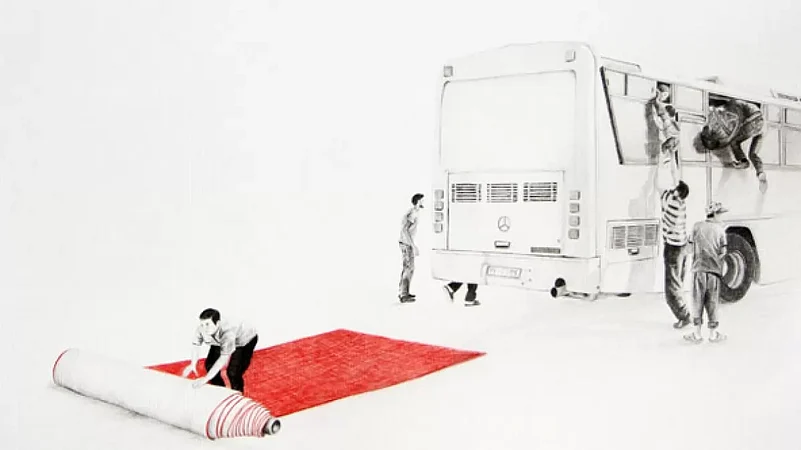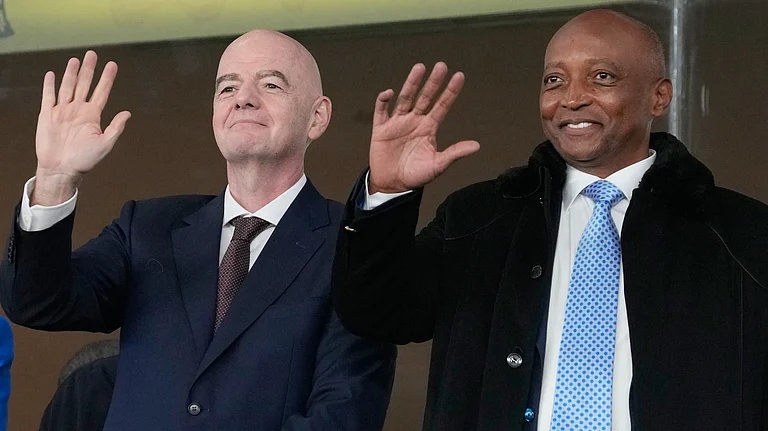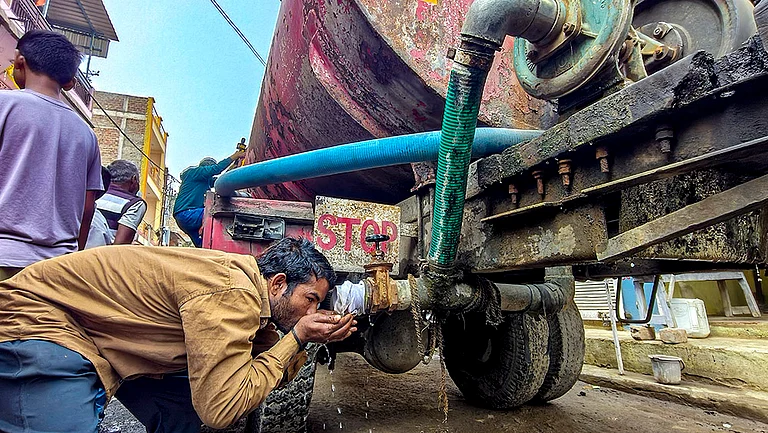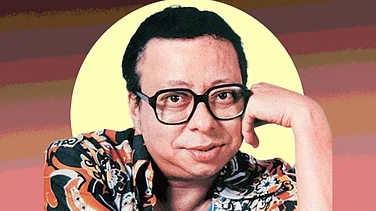Through a set of drawings, random figures, and short animations on a loop, Massinissa Selmani teases and provokes us, triggering our imagination. As if he almost wants us to solve a puzzle but through our own reading and context. His ambiguous drawings, some even mimicking cartoons and inspired by, among many things newspaper clippings, showcase the art of absurdism to create situations that are unlikely to happen. But seem so familiar. These improbable assemblages add a comic element to tragic situations of political and social life.
The Algeria-born artist Massinissa Selmani, whose work features at the Kochi-Muziris Biennale 2022, speaks to Outlook on the messages behind his ‘absurd’ work and experimental drawings in which he showcases violence, conflict, and the media.
Your work seems politically rooted to me. There was a lot of messaging in it. You have added this element of nonchalance to the drawings but they seem to narrate rather serious issues. Is there any political philosophy behind your work?
It is not really a political philosophy. It is the practice of drawing and experimentation. And then you have all the inspiration and background, etc. which is sometimes linked to how I grew up in Algeria. In a context where comedy and tragedy cohabit with each other. My interest in humor, newspapers, and the printed press, came from my childhood. My father is someone who likes to read newspapers. So, this was part of my daily life. I really like how cartoons and newspapers depict very complex situations; political or other events. Especially in the case of politics, how they break very complex situations using humor and absurdity. And for me, it was sometimes the best way to explain or to give a very interesting point of view about the situation.
I started collecting photographs from press clippings, and then I started to do drawings where I collected different characters from different newspapers. In the beginning, they did not have any relation between them but in order to create new situations which are unlikely to happen…. each character, and each element come from a context. When I put them together, I create a new context, and often the background is violent but the violence is diffused through the humor and absurdity. I also do animation and installations. My installations, if you saw them in Kochi, it’s very short and absurd. Actions that look funny but the loop turns them into tragedy.
That is what I was coming to, the question of comedy and tragedy. You say it was part of your growing-up experience. What exactly are you referring to? Were there any political or social conflicts that you witnessed growing up?
No, not exactly. This is something in progress. What interests me is not a specific event. I am more invested in complex situations. Situations where there is a conflict. I don’t prefer to focus on specific events, especially in my drawings. If I specify a specific place or people, I think drawings will not work the way I want. But from time to time, I add another aspect to my work where I develop something. Where I think of drawing as a documentary form. And in doing so, I like to focus on historical events or something similar. But I do that just from time to time and where drawing is considered the first documentary form.
I grew up in Algeria in the 1990s. It was during the civil war there. It was violent. Humor was a form of resistance. So, people laughed a lot. It’s probably not specific to Algeria, but people need to laugh in very complicated situations. It is a way to breathe. The political situation in Algeria until now was very complicated. Of course, it has a kind of influence on my work, on my perspectives. But my work is not directly related to Algeria. Sometimes there is a direct inspiration, but I collect newspapers from everywhere. Even when I was in India, I bought some.
Your work could have a universal meaning. It could be placed in any country or in any situation and still convey the complexity of violence and conflict. To a common person trying to understand or decipher your art, it seemed like a puzzle. Was that your intention? To compel the viewer to contemplate and imagine the drawings in their own life?
It is indeed something I do on purpose. I like it when artwork asks for some effort from the viewer. I like doing this even when I go visit the exhibition of other artists or in the museum.
In the drawings, the situation may look familiar but in reality, it is not. If you take a picture, for instance, I draw a protestor during a strike. It is the same gesture everywhere. You cannot recognize the protester. If you don’t have the context, you are lost. That is what I like to play with. Also, I assume that some people can be totally insensitive to this. That is something I completely accept. It is also, like you said, an attempt to make things universal and give the audience a space to bring their own knowledge and personal perceptions to the drawings. This is why if I put a figure that you can recognize, it bogs what I am trying to do. Because it is not related to the specific situation but the complexity of some situations. I interpret a situation and conflict as an object. This is why it is not related to a specific place. Also, it is around the signs of violence, the sign of conflict. Sometimes I bring it almost to abstraction so people can bring their own reading to the work.
Could you explain the concept of absurdism in art? Your work is absurd, comic, and tragic at the same time. You add these elements. I have seen a random flag in one drawing. You contrast black and white. In another drawing, there was a red carpet being spread for people, perhaps refugees, escaping some conflict in a bus.

I don’t have a theory on absurdism. It is really related to the things that I like. For example, I am really influenced by Belgian serials because they are so funny and smart. And there is a kind of state of mind and mentality that I really feel familiar with even if it is in Belgium, another country, another context.
For me, some situations are really complicated in terms of politics and violence. The best way for me to depict that is through absurdity. To push the situation to be absurd. And for me, it is sometimes the best way to depict and even understand the complexity of the situation. To show how some violence or some conflicts are so ridiculous. Humor and absurdity for me are also ways to avoid the spectacular, to take a step back, understand and analyze. I don’t like very spectacular artwork. For eg. When someone talks about war and you see blood etc. For me, after this moment of shock, nothing remains. But it is just a point of view and perception. I prefer to deliver the complexities step by step.
Police and military personnel in uniform as well as the cactus plant figure commonly in your work. What do they represent? Why do you add these characters to your work?
It is usually a representation of power and conflict. Uniforms of the military and police are symbolism of authority and power; of conflict and institutional violence. But also as an instrument of measure and recording voice or image. Sometimes there are animals. I also like to draw things just because I like to draw them. Because it is just funny to draw them. What I want to say and what I like; I like to play with these two parts. The graphic research and the pleasure of drawing and documentation. What I can say and suggest to that.
You try to diffuse violence in your work. Guns feature but they are not shooting. There is frisking of people, tension in the background but you cannot see the violence. What is the backdrop for this and why do you diffuse the violence?
It is probably about the feeling of the threat rather than the violence itself. There is potential violence coming. You don’t know what it is exactly. It could be the feeling of fear or threat or an uncertain situation. It is calm but this calm may be broken by a tragic event. However, at the same time, this tragic event has to cohabit with absurdity and humor. And the comic is totally unexpected in this situation. In some drawings, I include a blue dog or an animal as something absurd or disconnected from the situation. This situation has one chance in a million to happen. But it is still one chance. It sounds familiar but is not necessarily familiar.
You seem to be critical of the status quo and power and even the media and how it functions. You seem to be mocking the TV media. You have shown them in different situations, recording things.
It is not that I’m mocking the media. I’m more interested in…now a little bit less, but earlier I was more interested in press photography. It is more about how the images are made. How the storytelling is constructed. In press photography, if you reframe the caption, you can change the perception of the image. It’s not really kind of a critique, it is more about the process of how you deliver from the event to its diffusions through media.
Sometimes it is to mock the power and show how absurd it is. I was fascinated by the police and military uniforms, and why they are wearing it. I found the shape of the uniform very absurd and ridiculous, to be honest. Why when we see a man in uniform it changes our perception of them. Under this uniform, there is a human just like you and me. But this is a way to condition people, those inside the uniform, and as well as those around the uniform. I try to play with these layers of reading and perception, my own interpretation, and pleasures of drawing.
Do you also use characters and moments from your personal life?
Yes, indirectly. There is nothing really from my personal life in my drawings. But it is an abstract personal life, maybe childhood souvenirs. Also, I said I have references from Belgian serials as well as montages from Algerian literature. And sometimes, things just come by accident.
How important is this approach of absurdism to reflect on our social and political lives, especially in times of censorship and a lot of control by corporates and the State? They keep an eye on what you are writing and what you are saying or drawing. In some countries, people are even getting arrested or killed for that.
When there is a situation of violence and oppression, absurdity can be used to show its ridiculousness. How it is so violent, without any logic and so unfair. You push it to its limits. If you push some logic of dictatorship or something. I mean all the time it is ridiculous. They are just scared by stupid things sometimes. They are scared by people publishing memes on the internet. This happened in Algeria. People were arrested just for stupid things online. Something nobody cares about. If you want to speak about that or show how the situation is, it is total nonsense. And absurdism shows that. It is a kind of distraction. How bizarre and totally disconnected things can cohabit at the same time.




















